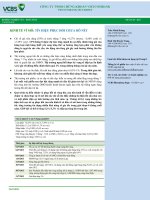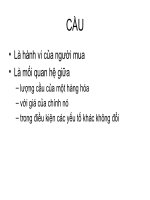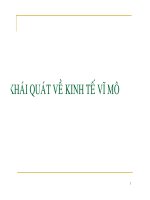Kinh tế vĩ mô Chap 8(1)
Bạn đang xem bản rút gọn của tài liệu. Xem và tải ngay bản đầy đủ của tài liệu tại đây (658.27 KB, 22 trang )
Chapter 8 Money and Monetary policy
Mentor Pham Xuan Truong
Content
I Overview of money
II Banking system and money supply
III Central bank and tools to control money supply
IV The theory of liquidity preference and monetary policy
I Overview of money
Definition
Money is any object or record that is generally accepted as payment for goods and
services and repayment of debts in a given socio-economic context or country.
In other words, money is a set of assets in an economy that people regularly use to buy
goods and services from other people
The functions of money
Medium of exchange: Item that buyers give to sellers when they want to purchase
goods and services
Unit of account: Yardstick people use to post prices and record debt
Store of value: Item that people can use to transfer purchasing power from the
present to the future
I Overview of money
The kind of money
- Commodity money: money that takes the form of a commodity with intrinsic value (Item
would have value even if it were not used as money)
- Fiat money: money without intrinsic value used as money because of government
decree
Measuring money volume
M0: Currency - Paper bills and coins in the hands of the public
M1: M0 and demand deposit (depositors can access on demand by writing a check)
M2: M1 and timely deposit (depositors in principle can access to the money as maturity
elapses)
The differentiation in measuring money volume bases on the gradual decrease of liquidity
(liquidity is the ease with which an asset can be converted into the economy’s medium of
exchange)
II Banking system and money supply
Money creation: fractional reserve banking
After receiving money from clients, banks have to lend or invest the money to make
profit so that it can primarily pay back interest rate. However to secure liquidity and
system stability, banks have to reserve money from clients’ deposit. Banks hold
only a fraction of deposits as reserves
Desired reserve rate/ratio (rr) is the fraction of deposits that banks hold as reserves.
It has two components
+ Required reserve rate (rrr): Bank must hold at the Minimum level set by country’s
central bank
+ Excess reserve rate (err): Bank may hold additional excess reserves
→ rr = rrr + err
II Banking system and money supply
Money creation: fractional reserve banking
We examine an example to see how banking system create more money
(money as definition) for the economy
The example has two assumption:
+ People don’t hold money in hand but deposit all to the banks
+ Desired reserve rate of each bank is similar (rr%)
The evolution: there is 1 unit value of money deposited in bank1. Bank 1
reserves rr and lends (1- rr) to people. People as assumed don’t hold money
and deposit to bank 2. Bank 2 reserves (1-rr).rr and lends (1-rr)^2 to people.
Then the process continues. The total deposits’ value of the economy increase
from the action of depositing 1 unit value of money at the beginning is
magnificent.
II Banking system and money supply
Money creation: fractional reserve banking
n +1
n +1
1
−
(
1
−
rr
)
1
−
(
1
−
rr
)
2
n
D = 1 + (1 − rr ) + (1 − rr ) + ... + (1 − rr ) = 1×
= 1×
1 − (1 − rr )
rr
0 < rr < 1 =>
1− 0
1
1
D = 1×
= 1×
=
= 10
rr
rr 0,1
II Banking system and money supply
Money supply model
+) Money supply: money as the most wide scope of understanding (M2)
MS(M) = Cu + D
where Cu currency circulated outside banks and D deposits in bank
+) Monetary base (basic money, high powered money): money as cash printed by
central bank (M0)
B (Ho) = Cu + R
where Cu currency circulated outside banks and R currency reserved by banks
II Banking system and money supply
Money supply model
Monetary multiplier (mM) is the fraction between MS and B
Denote Cu/D = cr (currency over deposit ratio)
R/D = rr (reserve ratio) (see the example)
→
mM
MS
cr + 1
cr + 1
=
=
=
B
cr + rr cr + (err + rrr )
II Banking system and money supply
Money supply model
Conclusions
Central bank cannot control entirely money supply due to cr (decided by
payment behavior of people) and err (decided by each bank)
Monetary multiplier has negative relationship with both rr (rrr) and cr
Period
1996-1997
2000-2001
2006-2007
2009-2010
mM of Vietnam
1,6-1,7
2,3-2,5
3-3,5
5-5,2
Math problems
1) Data have given as follows cr = 20% rr = 10% MS = 2000. Find B ?
2) Data have given as follows rr = 15%, MS = 3000, B = 500. Find cr ?
3) Data have given as follows cr/rr = 4, MS = 2000, B = 200. Find cr, rr ?
4) Data have given as follows cr + rr = 40%, MS = 1500, B = 500. Find cr, rr ?
5) A person deposited cash of 200 in a bank, given that cr = 20% rr = 20%. How much money supply increase ?
6) State bank of Vietnam (SBV) printed more cash of 1000, given that cr = 0% rr = 10%. How much money
supply increase ?
III Central bank and tools to control money supply
Central bank
Central bank is the institution designed to oversee the banking system and
regulate the quantity of money in the economy by monopolistic ability of
printing money (monetary policy). Central bank also regulates foreign reserve
of a country and represents the country in international monetary organization
or monetary agreement
Central bank could be a body of government but it could be independent from
government. Each type of organizational structure has advantage and
disadvantage
III Central bank and tools to control money supply
Tools to control money supply
1. Open-market operations: Purchase and sale of government bonds by central
bank
To increase the money supply: central bank buys government bonds
To reduce the money supply: central bank sells government bonds
2. Reserve requirements: Regulations on minimum amount of reserves that
banks must hold against deposits
An increase in reserve requirement: Decrease the money supply
A decrease in reserve requirement: Increase the money supply
3. The discount rate: Interest rate on the loans that central bank makes to
commercial banks
Higher discount rate: Reduce the money supply
Smaller discount rate: Increase the money supply
IV The theory of liquidity preference and monetary
policy
The theory of liquidity preference (money market)
This is Keynes’s theory which indicates that interest rate will adjust to bring money
supply and money demand into balance (we see nominal interest rate instead of real
interest rate; moreover in short run due to fixed price nominal and real interest rate are not
different)
Money supply
Money demand
Controlled by central bank
Money – most liquid asset (liquidity
Quantity of money supplied fixed by
preference)
central bank therefore doesn’t vary with
Interest rate (i) – opportunity cost of holding
interest rate
money. Income (Y) is the most determinant of
Money supply curve - vertical
money demand
Money demand curve – downward sloping
MD = f(Y, i)
MS = mM . B
IV The theory of liquidity preference and monetary
policy
The theory of liquidity preference (money market)
Equilibrium in the money market: Equilibrium interest rate will bring Quantity
of money demanded = quantity of money supplied
IV The theory of liquidity preference and monetary
policy
The theory of liquidity preference (money market)
If interest rate > equilibrium: Quantity of money people want to hold less than
quantity supplied → People holding the surplus buy interest-bearing assets →
Lowers the interest rate → People - more willing to hold money until equilibrium
If interest rate < equilibrium: Quantity of money people want to hold more than
quantity supplied → People - increase their holdings of money by selling
interest-bearing assets → Increase interest rates until equilibrium
IV The theory of liquidity preference and monetary
policy
The theory of liquidity preference (money market)
Change in money supply derived from
+ monetary policy of central bank: increase or decrease money supply
+ change in price level (with real money supply)
Change in money demand derived from
+ change in national income
+ change in price level (with nominal money demand)
+ financial market stability
+ payment technology
…
IV The theory of liquidity preference and monetary policy
(a) The Money Market
Interest
Money
rate
supply
(b) The Aggregate-Demand Curve
Price
2. . . . the increase in
1. When an increase in government purchases
level
spending increases
increases aggregate demand . . .
money demand . . .
4. . . which in turn
3. . . . which increases
r2
$20 billion
initial increase in
the equilibrium interest
aggregate demand.
rate . . .
r1
partly offsets the
MD2
AD2
Aggregate demand, AD1
Money demand, MD1
0
Quantity fixed
Quantity
by the Fed
of money
0
AD3
Quantity
of output
Panel (a) shows the money market. When the government increases its purchases of goods and services, the resulting increase in income raises the demand for money from MD 1 to MD2, and
this causes the equilibrium interest rate to rise from r 1 to r2. Panel (b) shows the effects on aggregate demand. The initial impact of the increase in government purchases shifts the aggregatedemand curve from AD1 to AD2. Yet because the interest rate is the cost of borrowing, the increase in the interest rate tends to reduce the quantity of goods and services demanded, particularly
for investment goods. This crowding out of investment partially offsets the impact of the fiscal expansion on aggregate demand. In the end, the aggregate-demand curve shifts only to AD 3.
IV The theory of liquidity preference and monetary
policy
Monetary policy
+ Expansionary monetary policy: central bank increases the money supply →
Money-supply curve shifts right → Interest rate falls → At any given price level
increase in quantity demanded of goods and services → Aggregate-demand curve
shifts right → output rises (unemployment rate decreases), price increases
Using expansionary monetary policy when economy is in crisis
+ Contractionary monetary policy: central bank decreases the money supply →
Money-supply curve shifts left → Interest rate increases → At any given price level
decrease in quantity demanded of goods and services → Aggregate-demand curve
shifts left → output falls (unemployment rate increases), price decreases (inflation
rate falls)
Using contractionary monetary policy when economy is in boom
Expansionary monetary policy
(a) The Money Market
(b) The Aggregate-Demand Curve
Price
Interest
rate
level
Money supply,
MS1
MS2
1. When the Fed
increases the
money supply . . .
r1
P
r2
AD2
0
Money demand
Aggregate
at price level P
demand, AD1
Quantity
2. . . . the equilibrium
interest rate falls . . .
of money
0
Y1
Y2
Quantity of output
3. . . . which increases the quantity of goods and
services demanded at a given price level.
In panel (a), an increase in the money supply from MS1 to MS2 reduces the equilibrium interest rate from r1 to r2. Because the interest rate is the cost of borrowing, the
fall in the interest rate raises the quantity of goods and services demanded at a given price level from Y 1 to Y2. Thus, in panel (b), the aggregate-demand curve shifts to
the right from AD1 to AD2.
20
Monetary policy vs fiscal policy
1.
Monetary policy focuses on investment (I) in GDP, fiscal policy focuses on
government spending (G) in GDP
2.
More open the economy is, more influence monetary policy is. More
severe economic downturn is, more influence fiscal policy is
3.
Inside lag of monetary policy is smaller than fiscal policy but outside lag
of monetary policy is larger than fiscal policy
Key concepts
Money, fiat money, commodity money
Liquidity
Monetary multiplier
Required reserve rate, excess reserve rate, desired reserve rate
Money supply
Money demand
The theory of liquidity preference
Central bank
Open market operation, reserve rate requirement, discount rate
Expansionary monetary policy, contractionary monetary policy









